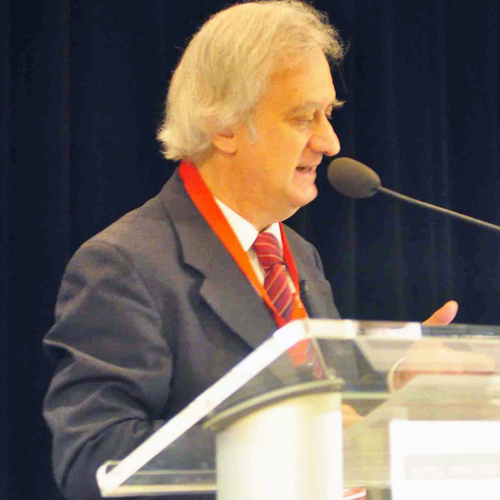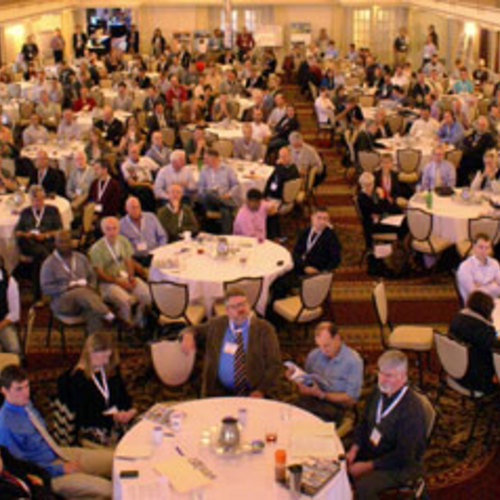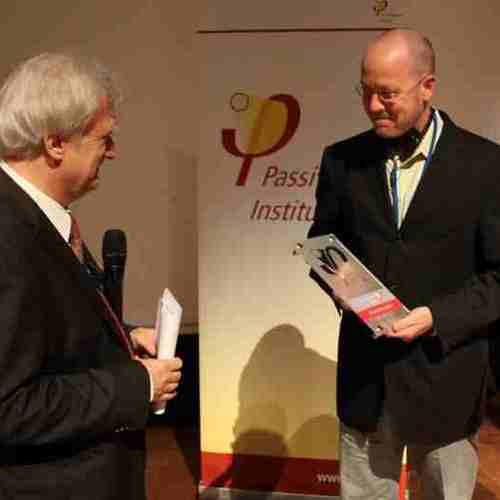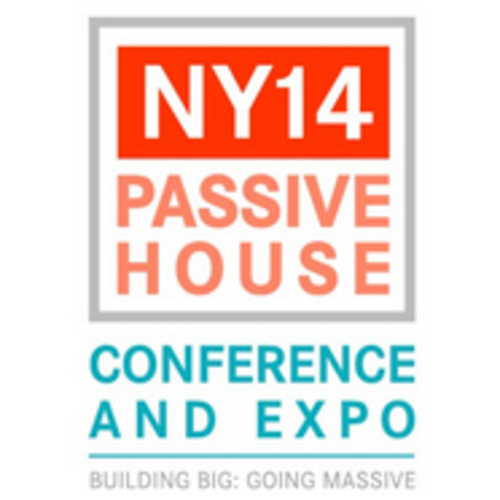Image Credit: All images: Ken Levenson
Image Credit: All images: Ken Levenson One of the sessions at the 2015 International Passive House conference in Leipzig, Germany. Bronwyn Barry, Bjorn Kierulf, Dylan Lamar, Rainer Pfluger, Zuzana Kierulfova, and Nick Grant at the Leipzig conference.
The 19th Annual International Passive House conference was held in Leipzig, Germany, on April 17-18, 2015. With large contingents attending from North America and China, as well as an emerging group of practitioners stretching across the Mediterranean from Turkey to Portugal, the global effort of Passive House was palpable.
Compared to previous years, project types continue to expand, from factories, to office complexes to day-care centers. So do the details: optimizing thermal bridges, earthquake load requirements, incorporating wood-fired furnaces, and onsite renewables.
As with the other conferences before, there was a dizzying array of information sharing and professional networking. I’m going to try to boil it down to a few themes.
Building materials: better windows and ventilation equipment
A key theme to delivering solutions for any particular place is the development and availability of the best possible components. Dr. Wolfgang Feist, director of the Passivhaus Institut (PHI), opened the conference with a detailed discussion of developing component technologies for insulation, windows, and ventilation, heating, cooling, and dehumidification systems. “Today the investment costs for improved efficiency of building components are exceptionally low; the cost difference is more than compensated through the saved energy costs,” said Dr. Feist.
Certified windows are getting better while prices are dropping. It is clear that large-scale manufacturing and wide availability and use of critical components are essential to improving cost-effectiveness.
Senior PHI scientist Dr. Benjamin Krick presented the 2015 Component Awards, which focused on window components suitable for retrofit applications. With 41 qualifying entries, the quality of the winners was exceptionally high, including First Prize windows by Optiwin and Smartwin.
It was announced that 2016’s conference will feature competition winners for outstanding ventilation solutions in retrofit applications.
Many sessions covered innovative application of high-performance components. For example, a presentation by Allen Gilliland of One Sky Homes (San Jose, California) focused on simplified approaches to ventilation and space conditioning.
More retrofit projects
While Passive House retrofits have been happening for a long time, each year the dominance of retrofitting grows. PHI’s retrofit standard, EnerPHit, is used increasingly in many countries.
Susanne Theumer and Maria del Carmen Rivero Arias, both of PHI, presented on a study of the successful applications of the EnerPHit standard across the 16 climate zones of Mexico. They concluded that EnerPHit “has once again proved to be the best option for achieving energy efficiency without compromising comfort or cost efficiency in the case of building modernizations, even for the analyzed examples within the warm and hot climate zones.”
Many sessions were dedicated to examining retrofits. One presentation discussed a study of retrofit work at 20 residential units in the United Kingdom. Another focused on product innovations, including Fixit 222 Aerogel, an insulating plaster mix product that incorporates aerogel insulation.
Passive House Academy director Tomas O’Leary provided an update on the EuroPHit Project, a three-year project funded by the European Union. The study involves 20 refurbishment projects in several countries, from Spain to Sweden. Project organizers hope to develop new tools and materials for wide-scale implementation. O’Leary said, “EuroPHit contends that it is best to develop a refurbishment plan for buildings which might span several years (or even decades) and to do a deep retrofit on a step-by-step basis to ensure that in the end the EnerPHit standard is reached.”
Other presentations discussed retrofits of office complexes, high-rises, and historic landmarks. These presentation made it remarkably clear that in many ways, the future involves retrofits.
Sharing data
If you are a data junky, this conference was the place for you. Numerous presentations provided extensive data: date on component and equipment performance and data on user satisfaction, including extensive data from residents and workers in the new Bahnstadt District in Heidelberg, Germany.
Nick Grant of Elemental Solutions in the U.K. showed how data collected from several school projects informed the teams’ evolving process of design and PHPP optimization, leading to ever-better school buildings. (His presentation is online here.)
Germany’s energy transformation
The Passivhaus Institut has introduced a new visionary primary energy calculation, Primary Energy Renewable (PER), as well as new Certification levels, Plus and Premium, which acknowledge the benefits of on-site renewable production. In PHI’s formulation, the fundamental resilience of a building enclosure is not lessened by adding renewables. The renewable energy production is not in the service of making a building a “survivalist island” (my term), but instead is distributed to the grid to contribute to the survival of society.
Listening to the various talks on the subject, it occurred to me that, just as American businesses helped reshape our global economy with such drivers as the personal computer and the Internet, something similar is happening with the German Energiewende (or energy transformation) that is leading the global shift from a fossil-fuels-based world economy to one based on renewable energy production. A post-fossil-fuel world will be based on interconnected producers of renewable energy, on energy storage technology, and on efficient energy use. This is not unlike the power our personal computers provide: not in isolation, but through their Internet connection.
PHI scientist Jessica Grove-Smith gave a detailed explanation of what’s under the hood of the new PER and the new certification levels. And Benjamin Krick walked through project examples, showing challenges and opportunities in reaching the new Plus and Premium categories.
All the new calculations are made with the new updated Passive House Planning Package (PHPP), Version 9 – an English language as well as an IP version will be available to US practitioners in the Fall of this year.
(If you are planning to attend the NYPH Passive House Conference, you can see Jessica Grove-Smith provide an in-person 60-minute presentation and Q&A session on these topics on June 11, 2015.)
A global community
This conference allows attendees to meet and learn from practitioners located around the world. There was a series of talks on fast-paced developments in China. There were sessions on the challenges of building in Russia, on new buildings in Spain and Italy, and on an embassy in Kinshasa, Congo. This international sharing shifts our perspective from the limits we face every day to the possibilities everywhere – it was liberating. Of course North America was well represented, with presentations (in addition to the one by Allen Gilliland mentioned above) by Matthew O’Malia of G-O Logic, Sam Hagerman of Hammer and Hand, and Adam Cohen of Passiv Science.
It was a special treat to meet living legend Harold Orr, who received the fourth Passive House Pioneer Award. Accepting the award in the closing plenary session, Orr gave a moving talk on the development of the Saskatchewan Conservation House, noting, “You can’t build a solar house in Regina because the sun has no energy by the time it gets there.” He also said, “Lots of insulation and airtightness – that’s what works.”
Finally, following what seems to now be an established tradition, the North American Passive House Network (NAPHN) Dinner was held on Saturday evening. This year the dinner was organized by NAPHN board member Andre Harrmann, a Leipzig native. With 120 attending, we unwound while meeting more great people – from North America, the U.K., Latvia, Austria, Belgium, Slovenia, and so on – discussing, into the night, the conference proceedings and our ongoing work, in the pleasant amber glow of German beer.
Next year’s conference
The 2016 conference, celebrating the 25th anniversary of the first Passive House in Darmstadt, Germany, will be held on April 22-23, 2016. I hope to see you there.
Ken Levenson is co-president of the North American Passive House Network, president of New York Passive House, and partner at 475 High Performance Building Supply.
Weekly Newsletter
Get building science and energy efficiency advice, plus special offers, in your inbox.
















0 Comments
Log in or create an account to post a comment.
Sign up Log in